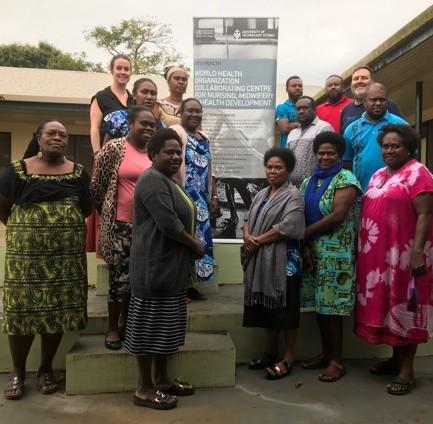Preparation, Prevention & Training – Vanuatu
The WHO CC UTS acknowledges use of key language from The WHO Global Strategic Directions for Nursing and Midwifery (2021–2025).
Disaster is core nursing business in the Pacific. Natural disasters - such as earthquakes, tsunamis, cyclones, floods, landslides, and droughts - disproportionately affect the Western pacific Region, causing devastation and destruction to communities, health infrastructure and health systems [1].

With a significant proportion, approximately 65%, of Vanuatu’s population exposed to natural hazards, the tiny country is currently ranked as the world’s most natural disaster-prone [1]. Excessive exposure to risk accounts for part of this picture, as very little of the country has not been previously exposed to some kind of natural disaster, but unlike most other countries, Vanuatu cannot change where its citizens reside. The nation’s poverty, lack of infrastructure, and coping capacity adds to this burden. So when disaster strikes rescue efforts are difficult, if not impossible on occasion, as some of its tiny 86 islands are sparsely populated and remote [1].
Nurses and midwives contribute significantly to successful disaster response by engaging and partnering with local leaders, communities and schools, and communicating, collaborating and coordinating with other health workers [2]. It is vital that well-trained nurses take the lead in disaster situations and are able to, “Do the greatest good for the greatest number”, according to Nurse Leader, Anthony Cook.
For years, Anthony Cook has been nursing in the middle of intense situations dealing with emergency, critical care, and trauma patients. His current role is Disaster Manager for the South Eastern Sydney Local Health District in Australia. Most recently Anthony has been involved with delivering emergency and disaster-related education for nurses in Vanuatu, through the Vanuatu College of Nurse Education and the Ministry of Health, a country that understands innately the importance of having its health workers well-trained in emergency preparedness and response [3].
Anthony’s extensive training background with Australian Medical Assistance Teams (AUSMAT), a service that deploys medical staff and logisticians to disaster across Australia and in the region, had made him particularly well placed for this work.
Anthony explains that nurses in Vanuatu have incredible in-country knowledge around responding to disasters. The course he ran focused on preparedness and provided opportunities for collaborative awareness raising, practice, and reflection/refinement.
Emergency Nurse and VANMAT member from Port Vila Central Hospital, Jeffery Samana, who took part in the training, said that,
When disaster happens, it’s not business as usual. It’s really important to have a hospital disaster plan to help us be well-prepared and have well-coordinated, command-and-control in place to avert chaos. It’s better to be prepared than to be sorry.
And Operating Theatre Nurse, Elina Olul, at Vila Central added, “It’s really important to have a well-documented plan. At the moment we don’t have it, but it’s important because it will guide us to respond quickly”.
In order to apply the knowledge in context, Nurse Supervisor at Vila Central Hospital, Barry Saniel arranged for students to embark on a field trip to Efate, to better understand practical community application of disaster planning and response. Students were first taken to a local village, where a state of emergency has been declared due to the infestation of Coconut Rhinoceros Beetle. Here students heard from community elders regarding the impact of this disaster on their village, and also witness the structure of the operational control centre that had been set up by Vanuatu Biosecurity. Students then travelled to a small community village in a low-lying coastal environment that is likely to be impacted by natural disasters. The student feedback emphasised that the field trip enabled them to see the positive implications of a well-written disaster plan in action.
Anthony says it can sometimes be difficult getting hospital staff to undertake prevention and preparation training as they are often too busy with patients. They also think disasters won’t strike. But financially, it makes sense.
From a disaster perspective, for every dollar you spend on prevention and preparedness, you save seven dollars down the track in Response and Recovery,
he says.
1. University, U.N., World Risk Report 2016: Inadequate infrastructure pushes up the risk of disaster. Science Daily, 2016.
2. Region, W.H.O.W.P., Nurses and Midwives in action during emergencies and disasters - case studies from the Western Pacific Region. 2013, World Health Organization and APEDNN: Geneva, Switzerland.
3. Brown, D., et al., Provision of Technical support to Vanuatu College of Nursing Education for Development and Accreditation of Nursing Curriculum,, V.M.o.H. Department of Foreign Affairs, Editor. 2019, World Health Organization Collaborating Centre – Western Pacific Region: University Technology Sydney, Australia.
